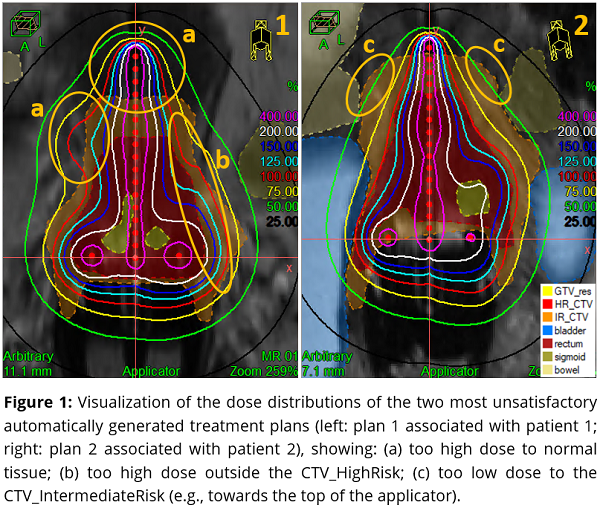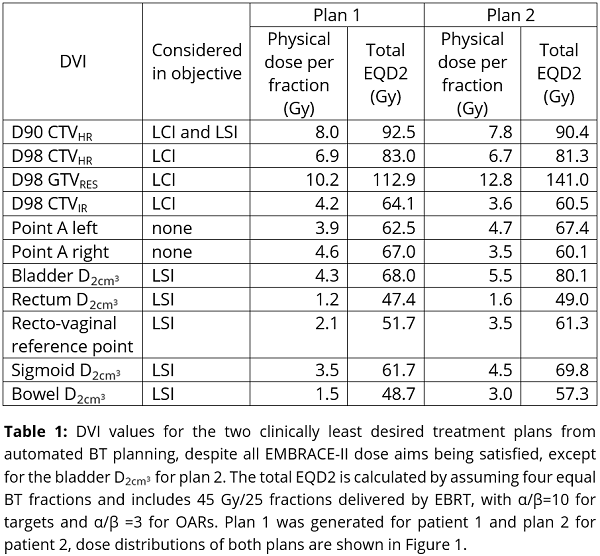Automated optimization for cervix brachytherapy requires more than the EMBRACE-II planning aims
Leah Dickhoff,
The Netherlands
OC-0445
Abstract
Automated optimization for cervix brachytherapy requires more than the EMBRACE-II planning aims
Authors: Leah Dickhoff1, Ellen M. Kerkhof1, Bradley R. Pieters2, Henrike Westerveld2, Lukas J.A. Stalpers2, Laura A. Velema1, Danique L.J. Barten2, Hugo Gratama van Andel3, Yury Niatsetski3, Carien L. Creutzberg1, Peter A.N. Bosman4, Tanja Alderliesten1
1Leiden University Medical Center, Radiation Oncology, Leiden, The Netherlands; 2Amsterdam UMC University of Amsterdam, Radiation Oncology, Amsterdam, The Netherlands; 3Elekta, Brachytherapy, Veenendaal, The Netherlands; 4Centrum Wiskunde & Informatica, Life Sciences and Health, Amsterdam, The Netherlands
Show Affiliations
Hide Affiliations
Purpose or Objective
A bi-objective optimization model was
recently introduced that entails direct optimization on dose volume indices
(DVIs) specified in a clinical protocol. Optimizing this model gives a set of
treatment plans that represents trade-offs between target coverage and organ sparing,
which was shown to include clinically desirable plans for prostate HDR BT. We studied
the direct extension of this approach to cervical cancer BT, by optimizing BT planning
aims recommended by the EMBRACE-II protocol.
Material and Methods
The objectives in the optimization
model are the Least Coverage Index (LCI) and Least Sparing Index (LSI). Both
indices are functions that return the DVI (pertaining to coverage or sparing,
respectively) that is either most violated or least satisfied, making it the DVI
that is currently iteratively being optimized. The used optimization algorithm
is a GPU-parallelized version of the Gene-pool Optimal Mixing Evolutionary
Algorithm (GOMEA), using 200,000 dose calculation points (DCPs) and a time
limit of 180s (NVIDIA Titan Xp GPU). Resulting plans were re-evaluated on
500,000 DCPs.
To factor in the combined intracavitary
and interstitial nature of a cervix BT procedure, interstitial contribution was
constrained to be at most 30% of the total dwell time, while single interstitial
catheters could contribute up to 20%. The DVI aims of the targets and OARs were
taken directly from the EMBRACE-II protocol. Preliminary results showed clearly
undesirable locally optimized dose distributions and irregular dwell time
patterns. Consequently, the minimum dose to point A was removed from the model,
and smoothness in neighbouring dwell times was enforced by a dwell time
modulation restriction, where the factor f by which a dwell position
with dwell time t can vary from its nearest neighbour is f=2+5/t.
Retrospectively, bi-objective
automated treatment planning was done for three patients who had been treated
with MRI-guided BT, four fractions of 7Gy HDR each, in two implants. For each
of the six BT implants, the dose distributions and
DVIs of the treatment plan for which the worst value of the two objectives was
best, were
evaluated by two medical specialists.
Results
The automatically generated treatment
plans were judged as clinically unsatisfactory. The DVIs of the two most
criticised plans are given in Table 1. Their dose distributions are shown in
Figure 1. The following issues were deemed undesirable: too high doses to
normal tissue and outside the CTV_HighRisk, and too low
doses to the CTV_IntermediateRisk.


Conclusion
A key advantage of the automated bi-objective
approach is being able to quickly generate a diverse set of clinically
satisfying plans based on optimization of DVIs. Directly optimizing on the DVIs
in the clinical protocol worked well in prostate cancer BT, but, in cervical
cancer BT, using EMBRACE-II as the protocol, additional planning aims are
required to achieve desirable plans. We are currently developing and adding these
to the model, indicating promising improvements.